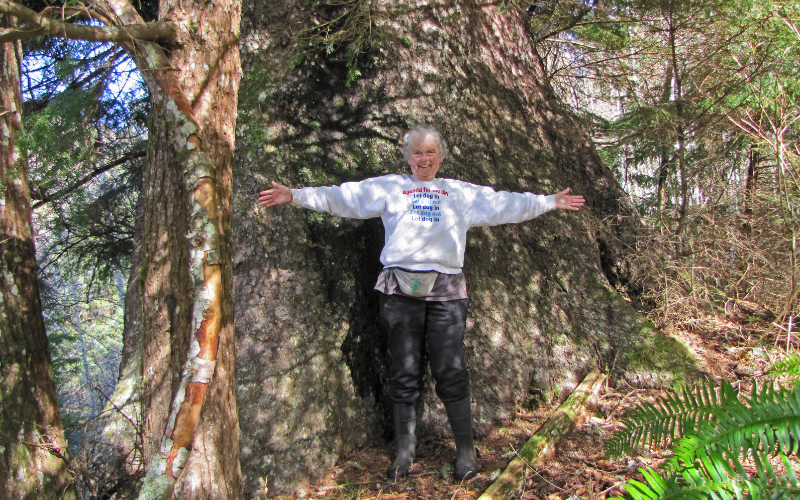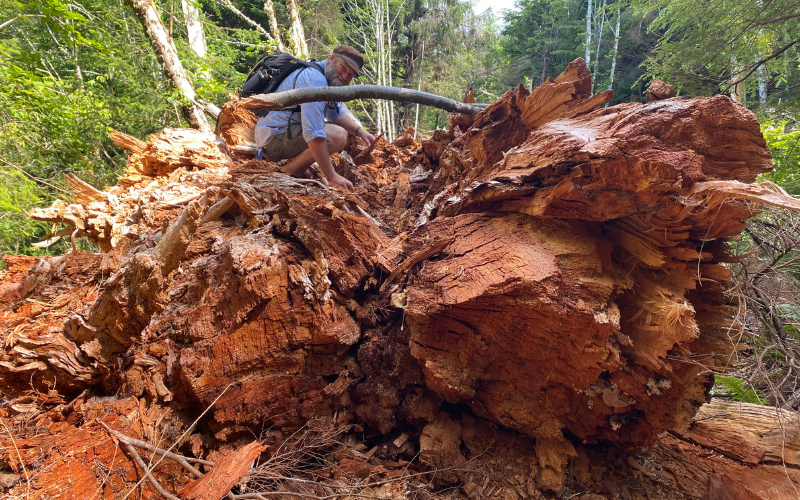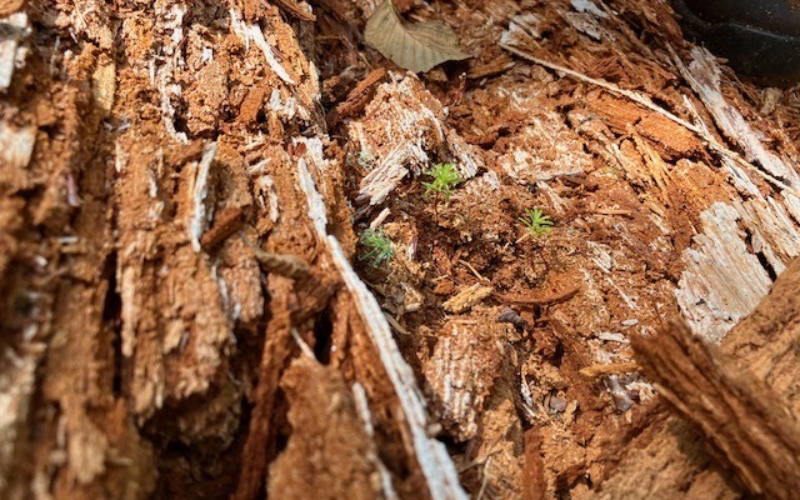
Sue Gabriel in front of HeShe Bigtree in 2012.
By Intern Callista Martin
Contributions by Land Steward Colin Meston
There were a few non-negotiable activities that our stewardship team agreed we had to do on our way back north from a work trip in Yachats: A visit to the ghost forest in Neskowin to see petrified stumps. Checking out the Nestucca Bay National Wildlife Refuge to try and catch a glimpse of an elusive Oregon silverspot butterfly. And, of course, a hike up to say “hello” to HeShe Bigtree at Butte Creek Habitat Reserve.
 After a long walk that involved wet brush, ripe berries, and seeing many happy frogs leaping across the trail, we approached HeShe’s home. Stewardship Director Melissa Reich, who was leading the pack, suddenly paused in confusion. There was bright sunlight ahead of her where there should not have been.
After a long walk that involved wet brush, ripe berries, and seeing many happy frogs leaping across the trail, we approached HeShe’s home. Stewardship Director Melissa Reich, who was leading the pack, suddenly paused in confusion. There was bright sunlight ahead of her where there should not have been.
As our eyes adjusted, we saw on the ground before us the tippy top of a downed tree. We saw clear sky where the dense canopy had been parted by its fall—alder trees in its path snapped like matchsticks—and several hundred feet down the resting trunk, an immense stump.
HeShe had fallen.
On the way to the property, conversation had been directed to me as the intern, sitting sandwiched in the middle of the back seat. It was impossible for the others to share with me the history of the property—and the history of HeShe Bigtree—without telling me about the late Sue Gabriel, who donated a significant portion of the land that comprises Butte Creek Habitat Reserve and who served as a site steward several years after.
Sue passed away in 2022, but she always held a special spot in her heart for HeShe Bigtree. And these two very different lives were intertwined to the end. In fact, Sue’s obituary read:
“Sue spent many hours walking her land and the adjacent forest, getting to know it intimately. She hailed it as a Qtopia, a conglomeration of her nickname (Suzy-Q) and the utopian life it afforded her. She loved every inch of Qtopia and its living creatures, from the salmon and lamprey in the creek, to the visiting elk and banana slugs, to the glorious blooms of skunk cabbage, camas and trillium.
Deep within Qtopia stands a massive Sitka spruce tree Sue named HeShe Bigtree, because the tree carries both male and female cones. HeShe became a spiritual center for Sue, and a source of much comfort in the last years of her life.”

Land Steward colin Meston with the fallen HeShe.
Sue’s connection to the tree was at the front of everyone’s minds as they reflected on the fact that after approximately 400 years of life, HeShe had gone within months of Sue. It may have been coincidence.
At least half of the tree’s heartwood was rotted because of an infection by either (or both) Phaeolus schweinitzii and/or Porodaedalia (Phellinus) pini, both of which cause the heartwood to crumble into small bits during the fungal infection. This infection weakened the tree, and a wind event likely blew it over this past winter. The tree had outward signs of stress, including the conks (mushrooms) of these fungi, as well as a large crop of cones, which is the tree’s last attempt to reproduce before dying.
Maybe it was just this heart rot finally taking its toll on the towering tree. Or maybe, HeShe simply could not go on without Sue. We hope two are united once again.
As for our little group, we experienced a mixture of grief and awe at the sight of the fallen HeShe. And something else. Though it was difficult to see the death of a tree that had been so special to Sue, and many others, there was also a sense of hope: HeShe will continue to provide support for the ecosystem around them. A true mother tree. This is the next phase of their life, and it’s an infinitely valuable one within the forest system.
We also recognize that it is a gift to have the opportunity to mourn this incredible Sitka spruce, when countless others like her were felled for their lumber without thought. And so, we gratefully feel sadness at the loss of HeShe—and we remember that with more people like Sue in the world, more protected and beloved trees will be given the chance to grow old, and there will be more stories just like this one.

Seedlings grow from a nurse log. This will be the next phase of HeShe’s life cycle.
A Closer Look: HeShe’s Biology and History
Heshe was a Sitka spruce (Picea sitchensis), which is a common conifer tree species that occurs near the coast, as well as some inland river bottoms. Most of the large trees of this species were harvested starting in the late 1800s to early 1900s, in part because of their easy accessibility to lowland logging operations.
During World War I, there was an entire division devoted to harvesting Sitka spruce for use in military aircraft, which further reduced the number of large trees. The wood is especially strong and light, making it useful for this type of construction, as well as having a quality resonance for use in the soundboards of musical instruments.
It is not clear why HeShe was spared from the mill. Perhaps the tree was used as a location or boundary marker, or perhaps they were just lucky.
All conifers in the family of Gymnosperms, such as Sitka spruce, have both male and female reproductive parts, or pollen and cones, which are often wind dispersed. Hence why Sue dubbed this beautiful tree “HeShe.”
Due to the rotten interior of the tree, it was difficult to estimate the exact age of HeShe. However, the outer 2 feet of the wood were intact, and there were 220 distinguishable growth rings, with the interior 6 inches of wood having a nice growth of 50 years. If the diameter was about 7 feet, then the estimated age would be about 400 years old. That means the seedling would have been established around the 1620s—about the time the Mayflower sailed to what is now called the United States.
Comments